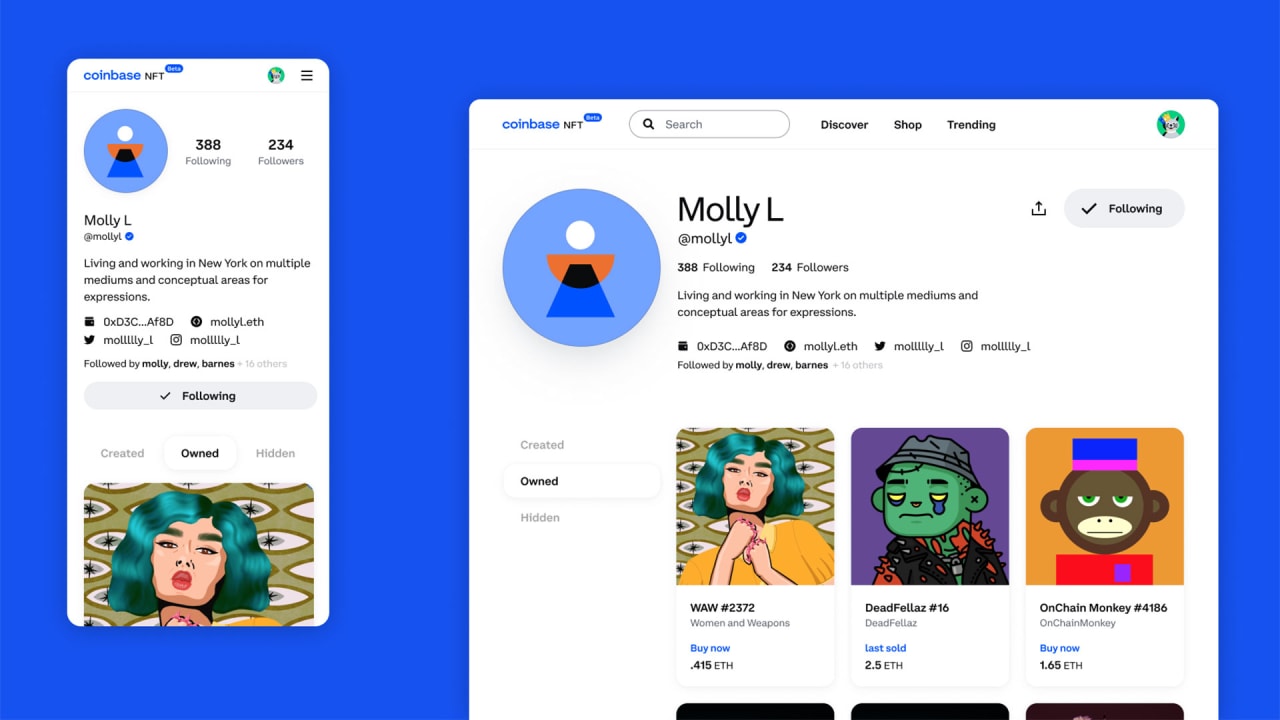[ad_1]

As Coinbase rolls out beta testing for its NFT trading platform Wednesday, it joins a host of cryptocurrency exchanges that are reconfiguring themselves for tokenized collectibles. In many ways, that’s a natural evolution for blockchain businesses, but unlike rival platforms, Coinbase NFT clearly aspires to go beyond just a hub to buy and sell goods. In fact, its user interface looks a lot like—dare we say it?—a social media app.
Coinbase first publicized the project back in October, when it released a waiting list for a forthcoming peer-to-peer marketplace that lets people trade, mint, showcase, and discover NFTs on the Ethereum blockchain. “If you’ve tried to create or purchase an NFT, you’ve probably found the user experience lacking,” it wrote in a blog post. “We’ll have a vibrant, secure marketplace. But we believe we can do much more . . . We’re designing for social engagement.”
Perhaps that’s been a long time coming. NFTs have already been inextricably linked to social media, with a large corner of the universe dedicated to PFPs, or profile pictures—2-D illustrations meant to serve as avatars for a buyer’s online presence. The crypto community unofficially lives on forums like Discord and Telegram, and congregates in Twitter threads. But if Coinbase NFT’s launch takes off, it might just become the Instagram of Web3.
That’s literal—the platform is starkly reminiscent of Instagram. Each user gets a profile page on a neat white background, with screen name, handle, avatar, and follower count at the top, followed by a set of images displaying NFTs imported from the user’s digital wallet. A “Discover” tab functions like a news feed, letting people scroll through an endless stream of NFTs—a green-skinned silhouette with cascading vines of hair from World of Women, an anime-style Azuki skateboarder carrying a katana—while marveling at the flow of digital content. Auctions can be favorited with a heart, and bids can be placed with the tap of a finger. When demonstrating the product, a Coinbase engineer stops on an NFT of a CloneX wearing a gas mask. This one’s cool, so he writes a comment under it: “Sick,” with a smiley face emoji.
Users in Coinbase’s social ecosystem can not just comment, but also view who previously owned the NFT, upvote or downvote, follow accounts to see other users’ NFT collections, or curate their own profiles by hiding select NFTs from the public. The door has been opened to someday amass a cult following as a Coinbase NFT influencer. Algorithms for the discovery feeds show you more of what you like, and less of what you don’t. There’s a “Trending” tab.
Moderation: the elephant in the room
But of course, there’s also the imminent dark side. The collision of social media platforms and the crypto-sphere may have gotten a prequel last week, when Dogecoin proponent Elon Musk threatened to buy Twitter in the name of free speech, and crypto-degens advocated for its leadership to become a blockchain-governed decentralized autonomous organization, a.k.a. DAO. Central to the fray was a discussion of how, exactly, free speech must exist in the modern world—and, implicitly, the challenges of maintaining or containing it.
That’s now a beast Coinbase must contend with, along with any trolls, scammers, or NFT copycats that flock to its platform.
In a media briefing, Coinbase’s vice president of product, Sanchan Saxena, suggested the platform would take a light hand when it comes to moderation. “We will respect everything that’s legal, and ban anything that’s illegal in the United States of America,” he said. “However, some other platforms have gone beyond that and started to interject their own perspective of what is good, and what is not. Coinbase will not be doing that. Our purpose is to give the artists and the community the freedom to express themselves in the ways they deem as the right representation of them and their art. We’re not in the business of judging what’s right and what’s wrong, as long as it abides by the law of the land.”
“This means the community on Coinbase NFT will be moderating themselves over time,” he added. Ensuring the authenticity of NFTs would be a joint effort between a team of Coinbase quality control and community members, which can flag any NFT as fake.
While commenting is currently centralized, Coinbase said it hopes to eventually decentralize more of its social features, including putting users’ follower graphs on-chain, so the social network can be carried over to other platforms in the future. It also addressed one of the more glaring caveats to the system, which is the issue of security, once everyone knows which wallets hold multiple million dollars worth of NFTs. Unfortunately, there seemed to be no good solution yet, except to switch from Metamask, or whatever other self-custody wallets out there, to custody under Coinbase’s “industrial-grade security.”
Coinbase’s NFTs will trade zero-fee for a limited time, before establishing a “low, single-digit” percentage fee. The company’s stock has sunk more than 50% since its IPO last spring.
[ad_2]
Source link

